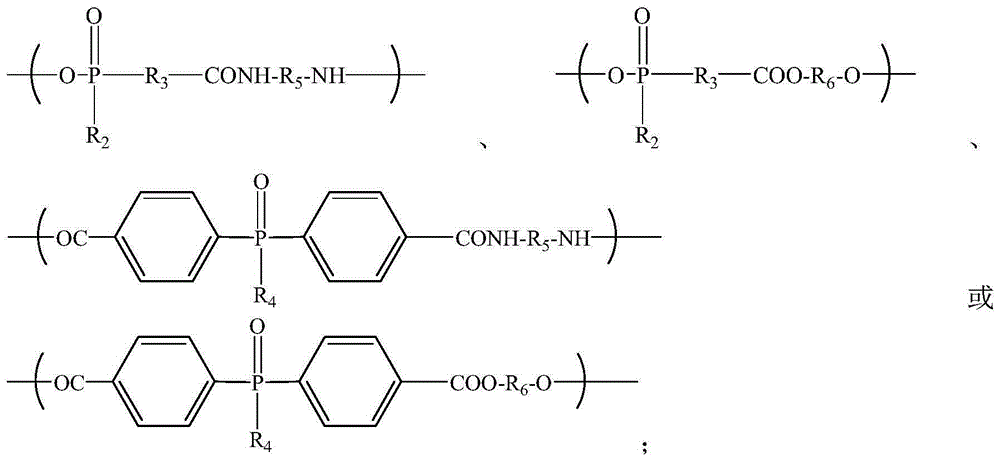Copolymerized flame-retardant polyamide 66 fiber and preparation method thereof
A flame retardant polyamide and copolymer flame retardant technology, applied in the field of flame retardant polyamide fiber synthesis, can solve problems such as affecting the spinning process of polyamide 66 fibers, limiting the use range of high polymers, and reducing the molecular weight of polymers, and achieves good results. The effect of hand feel and washing resistance, small influence on mechanical properties, and small amount of flame retardant
- Summary
- Abstract
- Description
- Claims
- Application Information
AI Technical Summary
Problems solved by technology
Method used
Image
Examples
Embodiment 1
[0036] A preparation method of a copolymerized flame-retardant polyamide 66 fiber, specifically comprising the following steps:
[0037] (1) Mix the flame retardant DDP, hexamethylenediamine with water, mix uniformly at 50°C for 2 hours under nitrogen protection, then stir and react at 90°C for 2 hours, then heat up to 150°C for further polymerization, and finally vacuumize under reduced pressure , after the reaction is completed, a flame retardant prepolymer is formed, which is a viscous liquid with a number average molecular weight Mn of 1.8 × 10 3 , the molar ratio of flame retardant DDP, hexamethylene diamine and water is 1:1.1:2, and both ends of the obtained flame retardant prepolymer are active end groups of a carboxyl group and an amine group respectively;
[0038] The structure of the flame retardant is:
[0039]
[0040] (2) 90 parts by mass of 66 salts and 1 part by mass of adipic acid are made into a 60% aqueous solution, mixed uniformly and added to the autocl...
Embodiment 2
[0048] A preparation method of a copolymerized flame-retardant polyamide 66 fiber, specifically comprising the following steps:
[0049] (1) Mix the flame retardant CEPPA, hexamethylenediamine with water, mix uniformly at 80°C for 3 hours under nitrogen protection, then stir and react at 130°C for 3 hours, then heat up to 180°C for further polymerization, and finally vacuumize under reduced pressure , after the reaction is completed, a flame retardant prepolymer is formed, which is semi-solid and has a number-average molecular weight Mn of 2.5×10 3 , the molar ratio of flame retardant CEPPA, hexamethylene diamine and water is 1:1.2:2.5, and the two ends of the obtained flame retardant prepolymer are respectively a carboxyl group and an amine group active end group;
[0050] The structure of the flame retardant is:
[0051]
[0052] (2) 96.8 parts by mass of 66 salts and 0.2 parts by mass of adipic acid were made into an 80% aqueous solution, mixed uniformly and added to th...
Embodiment 3
[0060] A preparation method of a copolymerized flame-retardant polyamide 66 fiber, specifically comprising the following steps:
[0061] (1) Mix the flame retardant BCPPO and hexamethylenediamine with water, mix uniformly at 60°C for 2.5 hours under nitrogen protection, then stir and react at 95°C for 2 hours, then heat up to 160°C for further polymerization, and finally vacuumize under reduced pressure , the reaction is over to generate a flame retardant prepolymer, which is a viscous liquid with a number-average molecular weight Mn of 2.8×10 3 , the molar ratio of flame retardant BCPPO, hexamethylene diamine and water is 1:1.2:2.1, and the two ends of the obtained flame retardant prepolymer are respectively a carboxyl group and an amine group active end group;
[0062] The structure of the flame retardant is:
[0063]
[0064] (2) 91.8 parts by mass of 66 salts and 0.2 parts by mass of adipic acid were made into a 66% aqueous solution, mixed uniformly and added to the au...
PUM
| Property | Measurement | Unit |
|---|---|---|
| limiting oxygen index | aaaaa | aaaaa |
| elongation at break | aaaaa | aaaaa |
| limiting oxygen index | aaaaa | aaaaa |
Abstract
Description
Claims
Application Information
 Login to View More
Login to View More - R&D
- Intellectual Property
- Life Sciences
- Materials
- Tech Scout
- Unparalleled Data Quality
- Higher Quality Content
- 60% Fewer Hallucinations
Browse by: Latest US Patents, China's latest patents, Technical Efficacy Thesaurus, Application Domain, Technology Topic, Popular Technical Reports.
© 2025 PatSnap. All rights reserved.Legal|Privacy policy|Modern Slavery Act Transparency Statement|Sitemap|About US| Contact US: help@patsnap.com



